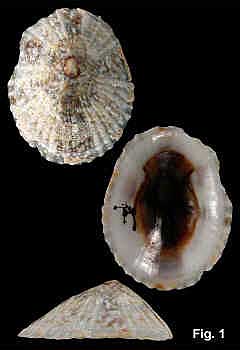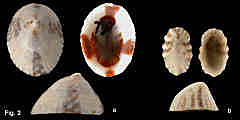|
|
|
|
|
Patelloida mufria (Hedley, 1915) Description: Shell flat to tall, anterior and posterior slopes straight or convex; apex in front of centre. Exterior with numerous radial ribs, usually wider than interspaces; often eroded. Exterior coloration variable; whitish, with dark radial bands, widening towards margin, sometimes forming a Maltese cross. Interior irregularly coloured with brown and white, or with external bands showing through. Spatula well defined; variable in colour. Margin scalloped by external sculpture, not differentiated in colour from rest of interior. Size: Up to 20 mm in length, commonly 8-10 mm. Distribution: Endemic to Australia: Ballina, NSW, to southern WA. Habitat: This species lives both intertidally and subtidally, on exposed and moderately exposed rocky shores; very common in NSW. Intertidally it lives on the shells of other molluscs, around Sydney particularly on the very common Austrocochlea porcata, and on Nerita, Turbo, Bembicium and the larger common limpet Cellana tramserica. It is apparently very intolerant of desiccation, because it lives on the lower surface of molluscs which shelter in pools when the tide recedes. It feeds on the film of microalgae on the host shell, and abandons the shell and moves to a new one when the food supply is exhausted (Mapstone, Underwood & Creese, 1984). It suffer heavy mortality during summer, and most die at a size of about 9 mm, when they become too large to be sheltered by their host shell. Subtidally, Patelloida mufria is much more common, with the bulk of the population living on encrusting coralline algae. In a study of the population at Cape Banks in Botany Bay, Fletcher (1988) found a density of up to 2000 individuals per square metre at about 2-3 metres depth, living on boulders with the surface a mosaic of encrusting algae, bare rock (covered by microalgae), and sessile animals. A lower population density was found on areas completely covered with coralline algae. These habits are shared with the larger limpets Cellana tramoserica and Patelloida alticostata, with which P. mufria competes for food. Being smaller, P. mufria exploits the areas that the larger limpets cannot access. In contrast to the intertidal population that feeds on microalgae, the subtidal animals feed on the early stages of the encrusting coralline algae. Subtidally, this species lives for up to two years, at which it reaches a size of about 20 mm. Fletcher found that the high density populations had a longevity of less than 10 months, and the low density animals up to 24 months. The intertidal animals have a life of 12-18 months, dying at a size of 7-9 mm in length. Comparison: Very similar to P. mimula, but generally with a strongly radially ribbed shell as opposed to the smooth or microscopically ribbed shell of P. mimula and with the Maltese cross darker and more well defined when present. P. mufria occurs on exposed and semi-exposed coasts in the lower littoral and sub-littoral, while P. mimula occurs in estuaries at a higher level on the shore, usually among oysters. The colour of the foot of P. mimula is orange, while that of P. mufria is grey. P. mufria is very similar in shell characters to the P. insignis (Menke, 1843), which occurs in southern Australia but does not reach NSW. However, P. insignis attains a larger size, and has a different radula to P. mufria. Synonymy: Radiacmea insignis cavilla Iredale, 1924 is a synonym. Due to the similarity of this species to Notoacmea flammea, Patelloida mimula and Patelloida insignis (which is a southern Australian species which does not reach into NSW), this species has been extensively misidentified in the literature, names used including Chiazacmea flammea cavilla (Iredale, 1924) and Chiazacmea flammea mimula (Iredale, 1924). Creese (1978) referred to it as Patelloida insignis (Menke, 1843). Remarks: The shape of the shell is variable, some specimens being minute, narrow and often tall (Fig. 2b), and are found living compressed between the ribs of Dicathais orbita, or among Galeolaria tubes. Larger, flatter specimens are found on smooth surfaces. Fig. 1 Long Reef, Collaroy, NSW (C.112762, specimen 2) Fig. 2 a. Long Reef, Collaroy, NSW (C.112762, specimen 1) b. Middle Harbour, NSW (C.032440) |

